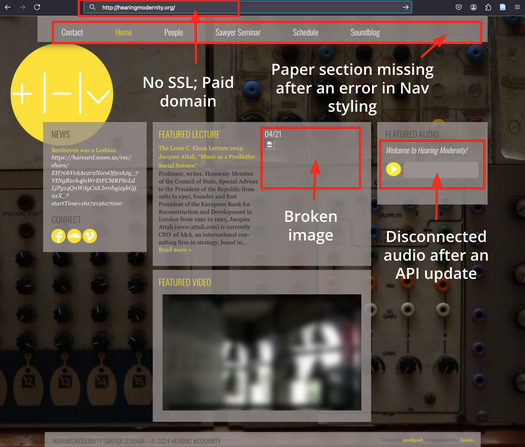Not everything lasts forever, and as digital humanities scholar Bethany Nowviskie notes, “We need to acknowledge the imperatives of graceful degradation, so we run fewer geriatric teen-aged projects that have blithely denied their own mortality and failed to plan for altered or diminished futures” (Nowviskie, 2015). Selecting an intentional sunsetting plan is a great option for projects for which the audience is expected to dwindle over time if it is, for example, associated with a specific course or scholarly experiment. If it is appropriate for your project, it is an act of forward-thinking pragmatism, as well as financial and environmental sustainability, as it recycles resources and storage that are no longer needed.
Both of the below options could be coupled with options under the “Preserving for the long-term” section, where you stop maintaining a project but explore preserving them in different ways. For example, you can implement a “static maintenance” plan after a project is finished with “active creation,” designate a satisfactory sunsetting date, and collaborate with archivists to preserve a record of the project for future generations.
Graceful degradation
Description: Defined in digital humanities as a project state where “you allow your work to persist for the foreseeable future by maintaining only its most basic functionality, allowing components to fail or become obsolete” (Visual Media Workshop at the University of Pittsburgh, n.d.). This entails allowing a project to bloom and fade, by designating a set duration for active maintenance after launch and then planning for minimal intervention. This option may still require security updates from staff, and your project team should clearly document and understand expectations. Like the Removal option, this could optionally be paired with one of the options under “Preserving for the long-term.”
Characteristics of project candidates
- Will not re-enter the active creation phase in the future
- No commitment to sustaining the ongoing maintenance past a designated time
- Term-limited resources (if depending on grant funding that requires preservation, can be explored in tandem with long-term preservation options)
- Audience that is expected to dwindle after a known duration – for example, if it is a study tool for a specific course or part of an experiment
Socio-technical considerations
- No technical considerations necessary (unless using this option in tandem with a preservation option, in which case, refer to that option’s considerations), as the project team will not need to anticipate future technical vulnerabilities or volatilities with the technical elements of the projects and it can destabilize incrementally
- Project stakeholders should carefully consider that lost functionality will be difficult to reimplement and be certain that this is an appropriate path
- Document clear expectations for when maintenance can end, if any maintenance activities (such as security updates) will need to continue, and what happens when those end as well
Example
This screenshot of a Harvard-based digital project demonstrates some of the ways a project that is not being maintained can begin to degrade.

Removal
Description: Designated and deliberate shut-down of a project from its access point/s, such as a website. Like the Graceful Degradation option, this could optionally be paired with one of the options under “Preserving for the long-term.”
Characteristics of project candidates
- Will not re-enter the active creation phase in the future
- No commitment to sustaining the ongoing maintenance past a designated time
- Term-limited resources (if depending on grant funding that requires preservation, can be explored in tandem with one of the options under “Preserving for the long-term”)
- Audience that is expected to dwindle after a known duration – for example, if it is a study tool for a specific course or part of an experiment
Socio-technical considerations
- Consider whether you want to pair this option with a long-term preservation option (below), where you can capture different components of the project for future reference, but can effectively shutter the website/access point
- No technical considerations necessary (unless using this option in tandem with a preservation option, in which case, refer to that option’s considerations), as the project team will not need to anticipate future technical vulnerabilities or volatilities with the technical elements of the projects and it can destabilize incrementally
- Ensure project stakeholders understand that choosing removal will make it difficult to re-implement and are clear on the timeline and shuttering expectations
Example
“A History of Medieval Christian Preaching as Seen in the Manuscripts of Houghton Library” was an online digital collection site that was decommissioned and removed, but an Internet Archive copy of it can be viewed here.